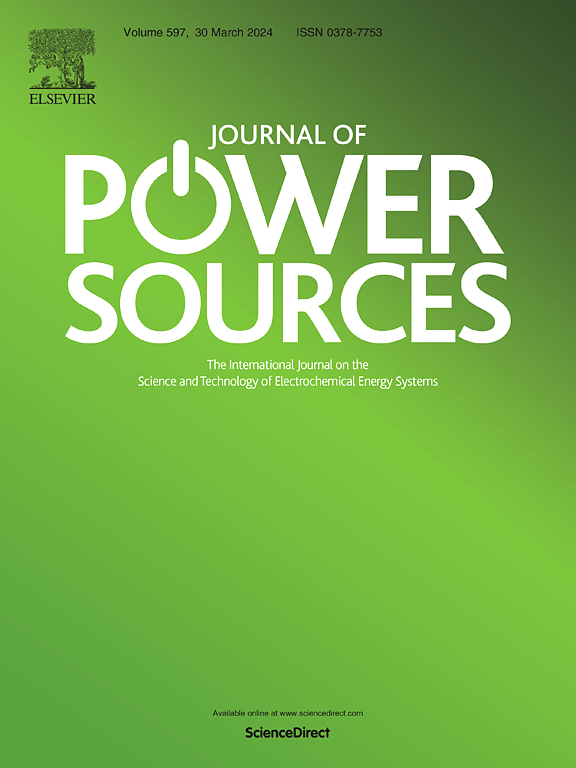IF 8.1
2区 工程技术
Q1 CHEMISTRY, PHYSICAL
引用次数: 0
摘要
本研究调查了 SrTi0.3Fe0.7O3-δ(STF)和 Sr0.95(Ti0.3Fe0.63Ni0.07)O3-δ(STF-Ni)作为固体氧化物电池燃料电极的电催化性能和初步耐久性,这些电池在 750 ℃ 下以 H2/H2O 和 CO/CO2 混合物可逆模式以及 H2O/CO2 共电解模式运行。在 3% 的加湿 H2 下,STF-Ni 的峰值功率密度达到 415 mW/cm2,并且在 H2/H2O 可逆运行 96 小时后仍能保持 96% 的性能。在共电解过程中,STF-Ni 在 1.4 V 电压下的最大电流密度为 540 mA/cm2,162 小时后在 1.2 V 电压下的性能下降了 15%。事实证明,在 CO/CO2 混合物中进行可逆操作是最具挑战性的,因为表面 SrCO3 的形成会导致显著的性能下降,只有 STF-Ni 才能达到稳定的性能。与 STF 相比,STF-Ni 在所有工作模式下都表现出更高的稳定性。利用 0D 模型分析了 STF-Ni 的 I/V 曲线:提取了燃料电极在 H2 和 H2O 混合物中的动力学幂律率,并证明了共电解中动力学对 CO2 量的不敏感性。利用 XRD、TPR、SEM 和 TEM 技术进行的补充表征突出了外溶解的作用。暴露于二氧化碳后,观察到外溶镍铁纳米粒子的组成发生了变化,铁选择性地重新并入到包晶结构中。本文章由计算机程序翻译,如有差异,请以英文原文为准。

Characterization and testing of strontium titanium ferrite-based solid oxide cells for reversible and co-electrolysis operation
This study investigates the electrocatalytic performance and the preliminary durability of SrTi0.3Fe0.7O3-δ (STF) and Sr0.95(Ti0.3Fe0.63Ni0.07)O3-δ (STF-Ni) as fuel electrodes for solid oxide cells operated at 750 °C in reversible mode with H2/H2O and CO/CO2 mixtures, and in H2O/CO2 co-electrolysis mode. STF-Ni achieved a peak power density of 415 mW/cm2 under 3 % humidified H2, and maintained 96 % of its performance over 96 h of H2/H2O reversible operation. In co-electrolysis, STF-Ni delivered a maximum current density of 540 mA/cm2 at 1.4 V, with 15 % performance drop at 1.2 V after 162 h. Reversible operation with CO/CO2 mixtures proved most challenging, as surface SrCO3 formation caused significant degradation, and stable performance was reached only on STF-Ni. STF-Ni consistently demonstrated superior stability compared to STF across all the operative modes. A 0D model was utilized to analyze the I/V curves of STF-Ni: a power-law rate for the fuel electrode's kinetics with H2 and H2O mixtures was extracted, and the kinetic insensitivity to the CO2 amount in co-electrolysis was proved. Complementary characterization using XRD, TPR, SEM, and TEM techniques highlighted the role of exsolution. After exposure to CO2, compositional changes in exsolved Ni-Fe nanoparticles were observed, with selective reincorporation of Fe into the perovskite structure.
求助全文
通过发布文献求助,成功后即可免费获取论文全文。
去求助
来源期刊

Journal of Power Sources
工程技术-电化学
CiteScore
16.40
自引率
6.50%
发文量
1249
审稿时长
36 days
期刊介绍:
The Journal of Power Sources is a publication catering to researchers and technologists interested in various aspects of the science, technology, and applications of electrochemical power sources. It covers original research and reviews on primary and secondary batteries, fuel cells, supercapacitors, and photo-electrochemical cells.
Topics considered include the research, development and applications of nanomaterials and novel componentry for these devices. Examples of applications of these electrochemical power sources include:
• Portable electronics
• Electric and Hybrid Electric Vehicles
• Uninterruptible Power Supply (UPS) systems
• Storage of renewable energy
• Satellites and deep space probes
• Boats and ships, drones and aircrafts
• Wearable energy storage systems
 求助内容:
求助内容: 应助结果提醒方式:
应助结果提醒方式:


